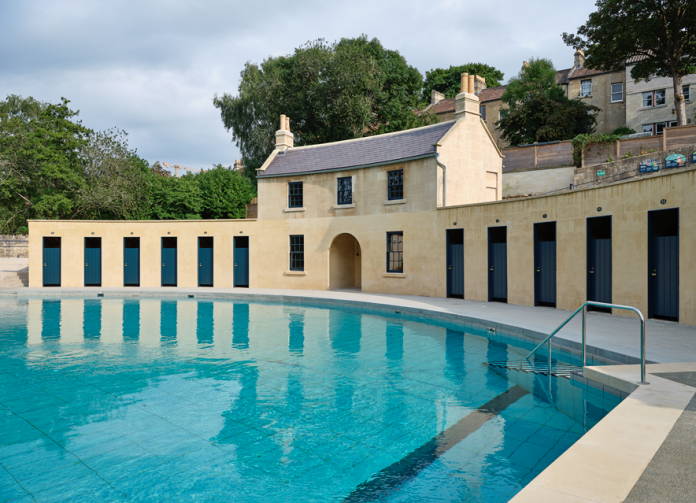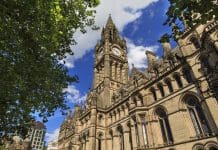Beard Construction has completed a £6.2m restoration of Cleveland Pools in Bath, the oldest lido in the UK
A 15-month project on the restoration of Cleveland Pools has been completed, with Beard Construction overcoming significant logistical challenges in the process.
Reclaimed materials and the original layout of the Grade II* listed site were used wherever possible
The work saw the creation of a new crescent-shaped waterproof concrete main pool within the footprint of the original listed red-brick pool, which was preserved beneath it.
Work began with the draining of the existing pool, followed by the installation of a system of drainage crates to allow natural spring water to continue to flow into the listed pool and around the shell of the new one.
The existing children’s pool walls were temporarily held in place while the team excavated out the base to construct the waterproof, below-ground plantroom. The pool-filtration equipment and water-source heat pumps will be housed here and used to provide heat for the pool water.
A refreshment kiosk and seating area are now located above the plantroom.
Curving around one length, the original Georgian changing rooms and a central cottage with archway have been made structurally safe, restored, and stripped of centuries of paint back to their original Bath stone.
The changing rooms have also been re-roofed in Welsh slate – some of which was reclaimed from the original roofs.
New terrace seating was also added, as well as a new toilet and shower block. Outdoor chrome showers also flank both pools.
Using the local river for sustainable heating and site access for development
The project to restore the decaying, 207-year-old Georgian site had significant logistical challenges – as all plant and materials could only be brought to the site by boat on the adjacent River Avon.
Machinery, building materials, equipment and everything else required to carry out the major refurbishment work was loaded up at the nearby Avon Rugby Club and carried up-river by barge.
The barge was limited to carrying five tonnes of material per trip and made about six trips a day -navigating around canoeists and kayakers who shared the river.
As well as allowing for access, water from the river will feed the water source heat pumps, providing the Pools with a sustainable heating solution when the pool fully re-opens to the public in spring next year and heating the pool to 28 degrees centigrade.
The pool is now ready to welcome its first swimmers. The pool will be open to the public for a preview, cold-water season on it’s Heritage Open Day, on Saturday 1 October 2022.
The restoration of Cleveland Pools is the culmination of an 18-year community campaign by the Cleveland Pools Trust
The trust’s campaign has taken the 207-year-old, Grade II* listed site from the lows of its closure in 1984 and a threat of demolition in 2003, to it’s present-day restoration.
The overall cost of the project is £9.3m, £6.47m of which came from The National Lottery Heritage Fund.
The project has also had significant support from the DCMS Capital Kickstart Fund, Historic England and Bath and North East Somerset Council.
Donald Insall Associates were lead designers on the project with Hydrock carrying out the structural design.
Anna Baker, chartered architect and project director, said: “I am proud to have played a part in a restoration that many didn’t believe was possible. It’s been complex and very challenging. But it’s also been unique, the project of a lifetime.
“We are a small project team and could not have done it without the help of our hundreds of volunteers. It’s been a real privilege to work on such a community-driven undertaking.
“I’ve especially enjoyed taking this from a community heritage scheme to a project which engages with wellbeing, culture, sustainable energy and the natural environment.”
Beard’s project manager Mark Tregelles added: “This has been a rare opportunity to restore a heritage building to its original use. Although logistically challenging, the overriding theme of this project has been collaboration. Working together with Anna, her team, volunteers and local residents has meant that no problem has been insurmountable.
“Having access only by river has really tested our initiative, not only getting materials in and out of the project but also in the method of construction, given the limited plant and equipment that we could get to the site. Overall, it has been an honour to breathe new life into a historic landmark which can now be enjoyed for generations to come.”














